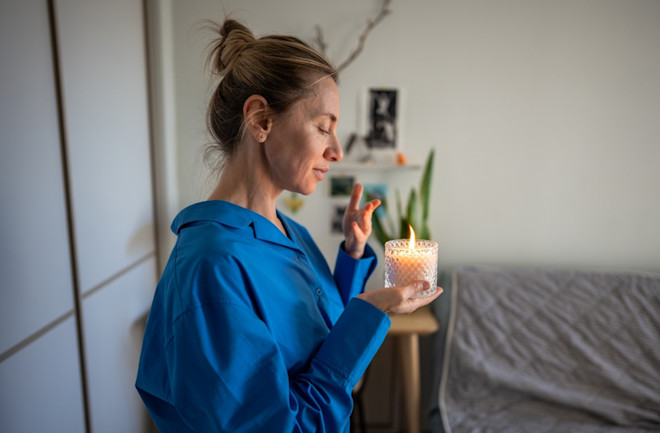Sweetened vanilla, calming lavender, or fragrant jasmine and lotus may fill your home with enticing aromas. But new research shows that the supposed stress-reducing and mood-enhancing effects of scented products may come with unwanted indoor pollution. “While these products are widely used to create a cozy atmosphere, their emissions can impact indoor air quality, especially in spaces with limited ventilation,” says Nusrat Jung, a civil engineer at Purdue University………Continue reading…..
Source: Discover Magazine
.
Critics:
Odor perception is a complex process involving the central nervous system and can evoke psychological and physiological responses. Because the olfactory signal terminates in or near the amygdala, odors are strongly linked to memories and can evoke emotions. The amygdala participates in the hedonic or emotional processing of olfactory stimuli.
Odors can disturb our concentration, diminish productivity, evoke symptoms, and in general increase a dislike for an environment. Odors can impact the liking for a person, place, food, or product as a form of conditioning. Memories recalled by odors are significantly more emotional and evocative than those recalled by the same cue presented visually or auditorily.
Odors can become conditioned to experiential states and when later encountered have directional influences on behavior. Doing a frustrating task in a scented room decreases performance of other cognitive tasks in the presence of the same odor. Nonhuman animals communicate their emotional states through changes in body odor, and human body odors are indicative of emotional state.
Human body odors influence interpersonal relationships and are involved in adaptive behaviors, such as parental attachment in infants or partner choice in adults. “Mothers can discriminate the odor of their own child, and infants recognize and prefer the body odor of their mother over that of another woman. This maternal odor appears to guide infants toward the breast and to have a calming effect.”
Body odor is involved in the development of infant–mother attachment and is essential to a child’s social and emotional development and evokes feelings of security. Reassurance created by familiar parental body odors may contribute significantly to the attachment process. Human body odors can also affect mate choice. Fragrances are commonly used to raise sexual attractiveness and induce sexual arousal.
Researchers found that people choose perfume that interacts well with their body odor. Body odor is a sensory cue critical for mate selection in humans because it is a signal of immunological health. Women prefer men with major histocompatibility complex (MHC) genotypes and odor different from themselves especially during ovulation. Different MHC alleles are favorable because different allele combinations would maximize disease protection and minimize recessive mutations in offspring.
Biologically females tend to select mates “who are most likely to secure offspring survival and thus increase the likelihood that her genetic contribution will be reproductively viable.” Studies have suggested that people might be using odor cues associated with the immune system to select mates.
Using a brain-imaging technique, Swedish researchers have shown that gay and straight males’ brains respond in different ways to two odors that may be involved in sexual arousal, and that the gay men respond in the same way as straight women, though it could not be determined whether this was cause or effect.
The study was expanded to include lesbian women; the results were consistent with previous findings that lesbian women were not as responsive to male-identified odors, while their response to female cues was similar to that of straight males. According to the researchers, this research suggests a possible role for human pheromones in the biological basis of sexual orientation.
An odor can cue recall of a distant memory. Most memories that pertain to odor come from the first decade of life, compared to verbal and visual memories which usually come from the 10th to 30th years of life. Odor-evoked memories are more emotional, associated with stronger feelings of being brought back in time, and have been thought of less often as compared to memories evoked by other cues.
A person’s odor can increase or decrease ratings of attractiveness because the olfactory receptors in the brain are directly linked with the limbic system, the part of the brain that is thought to be most involved with emotion. This link is important, because if an individual associates positive affect (elicited by pheromones), with a potential mate, their liking for, and attraction to, that potential mate will be increased. Although not a typically evolutionary hypothesis, this hypothesis is one that acknowledges how humans have adapted their mating strategies to modern-day societal norms.
Dispensable and indispensable amino acids for humans”. “
Essential oils: Poisonous when misused”.
How Are Essential Oils Extracted?”.
Business Plan – Essential oils”
Essential oil poisoning calls on the rise, children most affected”.
Aromatherapy: The Best Essential Oil Diffuser”.
Essential Oils May Be Wreaking Havoc on Your Skin”.
Essential Oils as Green Pesticides: Potential and Constraints”.
Wieviel Prozent Blausäure enthält natürliches Bittermandelöl?”.
Imroving the Efficacy of Essential Oils as Antimicrobials in Foods: Mechanisms of Action”.
Annual Review of Food Science and Technology.
Essential Oils and Waxes. Prepubertal Gynecomastia Linked to Lavender and Tea Tree Oils”.
Dispensable and indispensable amino acids for humans”. “
Essential oils: Poisonous when misused”.
How Are Essential Oils Extracted?”.
Business Plan – Essential oils”
Essential oil poisoning calls on the rise, children most affected”.
Aromatherapy: The Best Essential Oil Diffuser”.
Essential Oils May Be Wreaking Havoc on Your Skin”.
.
.
Labels:vanilla,lavender,fragrant ,jasmine, lotus.aroma,indoor, pollution,cozy, atmosphere,Allergic, Reactions,Aromatherapy,Turpentine ,aminoacid






Leave a Reply